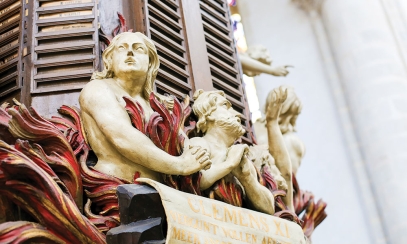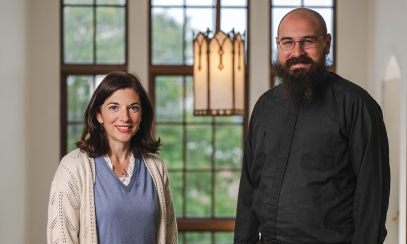
Thoughts Along the Road to Emmaus
On the Road to Emmaus is Bishop Earl Boyea’s new initiative aimed at deepening people’s love for Jesus Christ in the Holy Eucharist. It began in June and, so far, over 20,000 people have signed up to take part.
Over the course of a year, subscribers will receive a weekly multi-media communication from Bishop Boyea containing teaching, inspiration and a challenge relating to the Holy Eucharist including a step-by-step explanation of the key moments of the Holy Mass.
The first weeks of On the Road to Emmaus have been dedicated to the topic of worship and our approach to Sunday Mass.
On the Road to Emmaus is Bishop Earl Boyea’s new initiative aimed at deepening people’s love for Jesus Christ in the Holy Eucharist. It began in June and, so far, over 20,000 people have signed up to take part.
Over the course of a year, subscribers will receive a weekly multi-media communication from Bishop Boyea containing teaching, inspiration and a challenge relating to the Holy Eucharist including a step-by-step explanation of the key moments of the Holy Mass.
The first weeks of On the Road to Emmaus have been dedicated to the topic of worship and our approach to Sunday Mass.
It matters how we celebrate the Mass.
A 2019 Pew Research Center survey revealed that almost seven in 10 Catholics did not believe that the bread and wine brought to the altar at Mass become the body and blood of Jesus Christ. Almost half of the people did not even know that the Church teaches that the bread and wine are anything more than mere symbols! In response, the U.S. Bishops launched what they call a National Eucharistic Revival that aims in part to help us all rediscover the wonder of encountering the divine presence of Jesus in the Mass.
If this Eucharistic Revival is going to have any impact on belief in the real presence, it cannot be just words or even good teaching. It’s not just that we’ve been failing to teach the real presence. That’s part of it. People don’t believe it because it doesn’t usually look like other people believe it either.
If we believe that the Eucharist is “the personal, truly vitalizing flesh of God” (Cyril of Alexandria), do we behave like we are in God’s very presence? Do we receive the Eucharist as if we're receiving the “flesh of God”?
In the late 10th century, a delegation from the kingdom of Kievan Rus’ (modern-day Belarus, Ukraine and parts of Russia) ventured on a journey to find the true faith for their domain. Journeying from one territory to the next, they surveyed a host of peoples and witnessed the worship of many religions. After having returned from the solemn liturgy at the Hagia Sophia in Constantinople, they reported to their prince:
“Then we came to the edifices where they worship their God … We knew not whether we were in heaven or on earth. For on earth there is no splendor or such beauty, and we are at a loss how to describe it. We only know that God dwells there among men.”
The worship that attracted the delegation from Kievan Rus’ was not directed at them. The remarkable thing about the story of the way the liturgy evangelized the “Rus’” is that none of it was aimed at them. This loose federation of peoples didn’t even speak the language.
Nevertheless, what they found in the beauty of the liturgy was worship that was focused on God. “What was impressive about” the worship they experienced, Pope Benedict wrote, “was particularly its sheer lack of a practical purpose, the fact that it was being done for God and not for spectators; it was simply striving to be … before God and for God alone (Rom 12:1; 15:16).”
It might sound obvious to say it, but worship is for God. The evangelical power of worship is derived from the fact that it draws everyone and everything into the worship of God. This is precisely what makes worship dynamic. The dynamic quality of worship does not come so much from its outward expression, but from its God-ward direction — the One to whom worship is directed.
Reverent worship is attuned to the God in whose presence he has gathered us. Accordingly, we kneel, bow, genuflect, stand, sing, speak, keep silent and chant in ways that acknowledge the Lord who is present. Worship that is reverent responds to the presence of the Holy One and incites us to awe and even the “fear of the Lord” in his presence. (cf. Is 11:2-3) Reverence is that attitude and sentiment with which the sacrifice of Abraham was made pleasing to the Lord (see Gen 22:12). The exterior action helps to form our heart in such a way that honor and glory are given to God.
Our focus this month is on preparing for Mass, preparing to encounter the Lord in the Mass. In particular, one of Bishop Boyea’s “Road to Emmaus” challenges for July focuses on dressing for Mass. Obviously, the Lord is not evaluating us on our clothing, and neither should we evaluate each other. But, it’s worthwhile from time to time to evaluate ourselves. How we clothe ourselves speaks volumes about what we think of the event and the persons with whom we’re interacting. Whether we’re going on a date, meeting our future in-laws, interviewing for a job, or being introduced to the president, we dress in such a way that honors the people present and the occasion itself. Again, the exterior action helps to form our hearts in such a way that honor is given to the persons present. Sometimes, we feel like dressing a certain way, and sometimes, we don’t. Nevertheless, the way we dress can bring glory to God and assist each of us to encounter him more fruitfully. Our gestures and clothing “ought to convey the respect, solemnity and joy of this moment when Christ becomes our guest.” (CCC 1387)
To subscribe to On the Road to Emmaus with Bishop Boyea, text RTE to 84576 or go to the Diocese of Lansing website.
Jeremy Priest is the director of the Office of Worship and the chair of discipleship formation for the Diocese of Lansing.



